(PDF) Real-Time Big Data Analytics
VerifiedAdded on 2021/05/30
|15
|3504
|158
AI Summary
Contribute Materials
Your contribution can guide someone’s learning journey. Share your
documents today.

Running Head: REAL TIME ANALYTICS
Real Time Analytics
Name of the Student:
Name of the University:
Course ID:
Real Time Analytics
Name of the Student:
Name of the University:
Course ID:
Secure Best Marks with AI Grader
Need help grading? Try our AI Grader for instant feedback on your assignments.
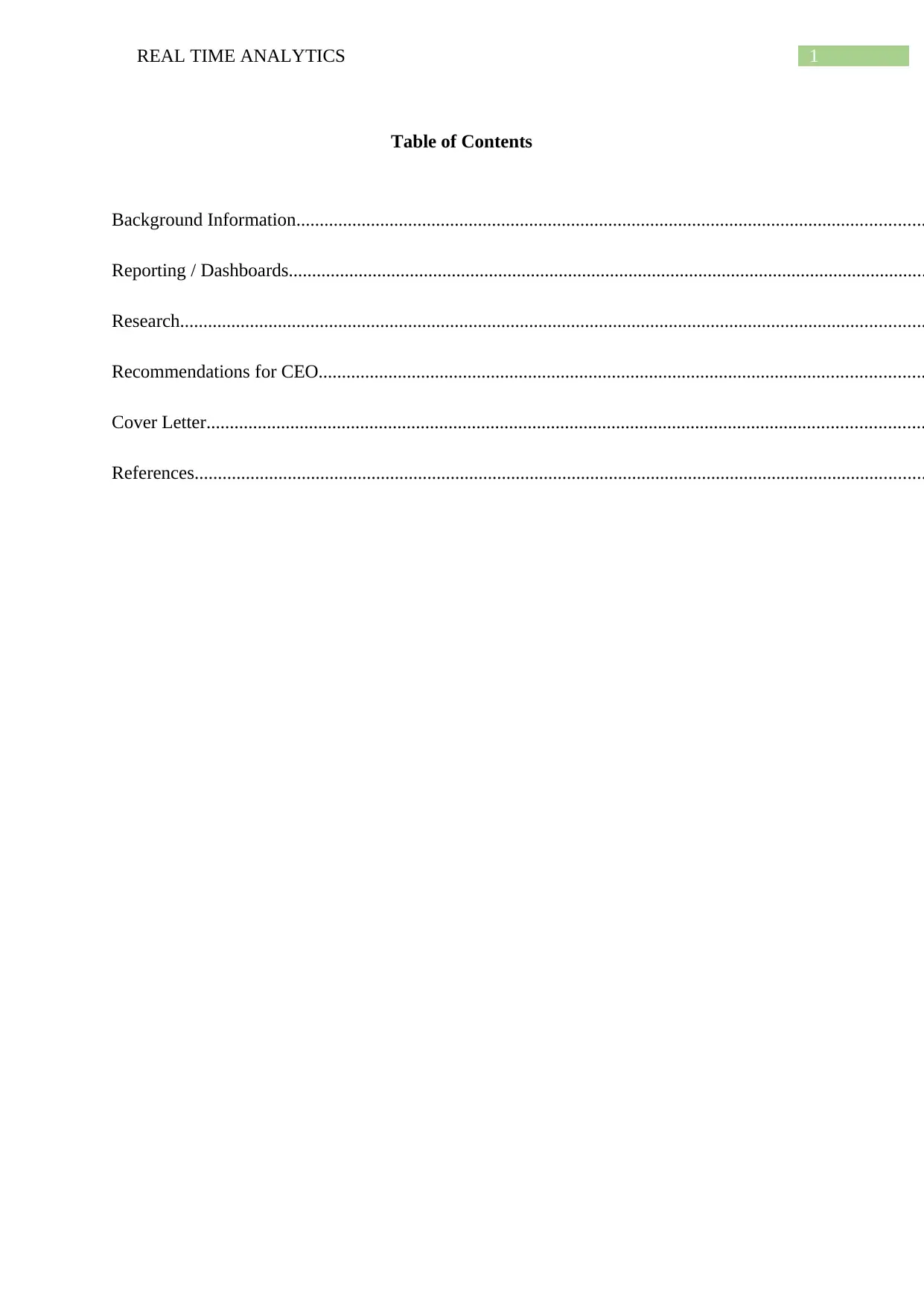
1REAL TIME ANALYTICS
Table of Contents
Background Information.......................................................................................................................................
Reporting / Dashboards.........................................................................................................................................
Research................................................................................................................................................................
Recommendations for CEO..................................................................................................................................
Cover Letter..........................................................................................................................................................
References.............................................................................................................................................................
Table of Contents
Background Information.......................................................................................................................................
Reporting / Dashboards.........................................................................................................................................
Research................................................................................................................................................................
Recommendations for CEO..................................................................................................................................
Cover Letter..........................................................................................................................................................
References.............................................................................................................................................................
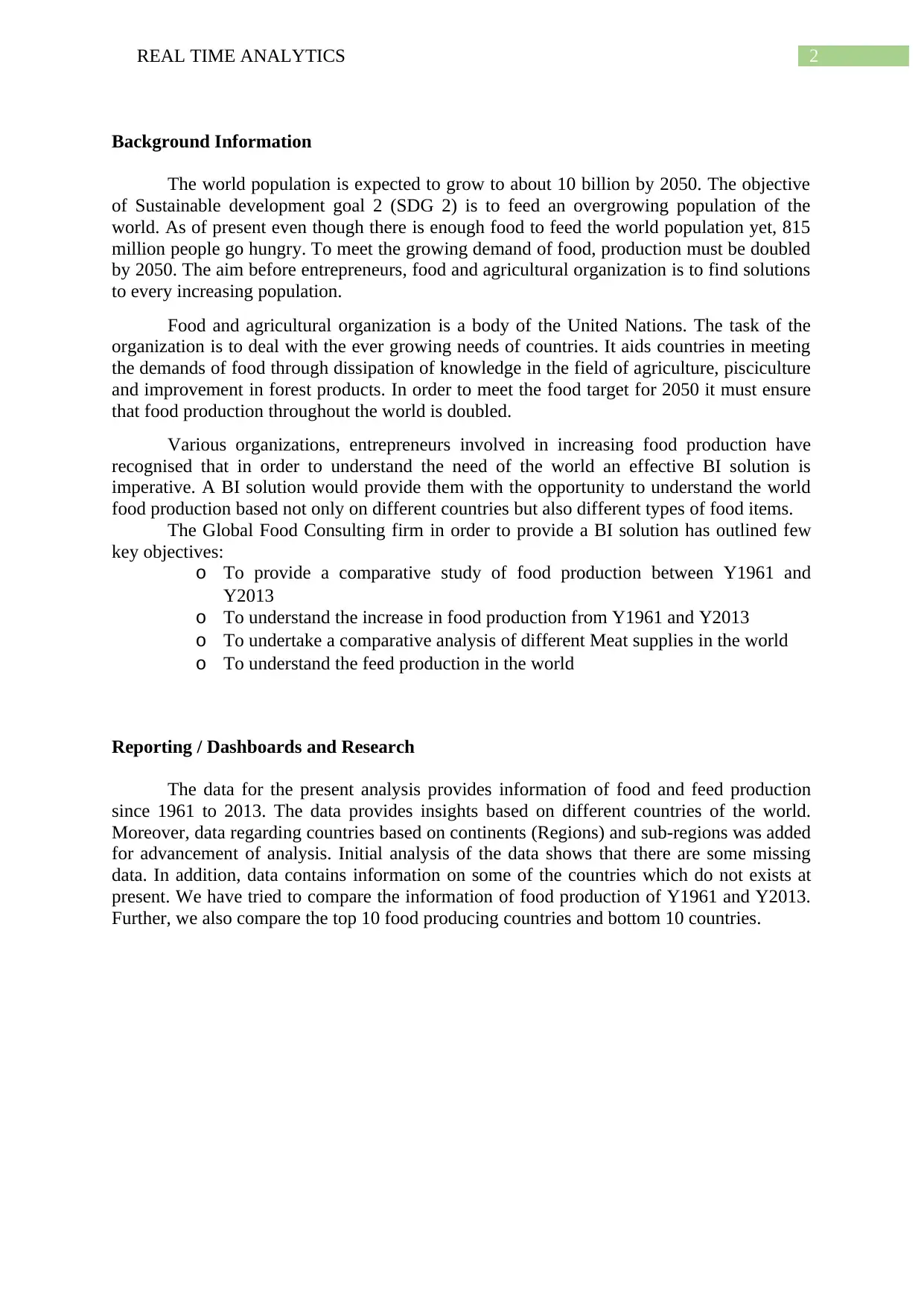
2REAL TIME ANALYTICS
Background Information
The world population is expected to grow to about 10 billion by 2050. The objective
of Sustainable development goal 2 (SDG 2) is to feed an overgrowing population of the
world. As of present even though there is enough food to feed the world population yet, 815
million people go hungry. To meet the growing demand of food, production must be doubled
by 2050. The aim before entrepreneurs, food and agricultural organization is to find solutions
to every increasing population.
Food and agricultural organization is a body of the United Nations. The task of the
organization is to deal with the ever growing needs of countries. It aids countries in meeting
the demands of food through dissipation of knowledge in the field of agriculture, pisciculture
and improvement in forest products. In order to meet the food target for 2050 it must ensure
that food production throughout the world is doubled.
Various organizations, entrepreneurs involved in increasing food production have
recognised that in order to understand the need of the world an effective BI solution is
imperative. A BI solution would provide them with the opportunity to understand the world
food production based not only on different countries but also different types of food items.
The Global Food Consulting firm in order to provide a BI solution has outlined few
key objectives:
o To provide a comparative study of food production between Y1961 and
Y2013
o To understand the increase in food production from Y1961 and Y2013
o To undertake a comparative analysis of different Meat supplies in the world
o To understand the feed production in the world
Reporting / Dashboards and Research
The data for the present analysis provides information of food and feed production
since 1961 to 2013. The data provides insights based on different countries of the world.
Moreover, data regarding countries based on continents (Regions) and sub-regions was added
for advancement of analysis. Initial analysis of the data shows that there are some missing
data. In addition, data contains information on some of the countries which do not exists at
present. We have tried to compare the information of food production of Y1961 and Y2013.
Further, we also compare the top 10 food producing countries and bottom 10 countries.
Background Information
The world population is expected to grow to about 10 billion by 2050. The objective
of Sustainable development goal 2 (SDG 2) is to feed an overgrowing population of the
world. As of present even though there is enough food to feed the world population yet, 815
million people go hungry. To meet the growing demand of food, production must be doubled
by 2050. The aim before entrepreneurs, food and agricultural organization is to find solutions
to every increasing population.
Food and agricultural organization is a body of the United Nations. The task of the
organization is to deal with the ever growing needs of countries. It aids countries in meeting
the demands of food through dissipation of knowledge in the field of agriculture, pisciculture
and improvement in forest products. In order to meet the food target for 2050 it must ensure
that food production throughout the world is doubled.
Various organizations, entrepreneurs involved in increasing food production have
recognised that in order to understand the need of the world an effective BI solution is
imperative. A BI solution would provide them with the opportunity to understand the world
food production based not only on different countries but also different types of food items.
The Global Food Consulting firm in order to provide a BI solution has outlined few
key objectives:
o To provide a comparative study of food production between Y1961 and
Y2013
o To understand the increase in food production from Y1961 and Y2013
o To undertake a comparative analysis of different Meat supplies in the world
o To understand the feed production in the world
Reporting / Dashboards and Research
The data for the present analysis provides information of food and feed production
since 1961 to 2013. The data provides insights based on different countries of the world.
Moreover, data regarding countries based on continents (Regions) and sub-regions was added
for advancement of analysis. Initial analysis of the data shows that there are some missing
data. In addition, data contains information on some of the countries which do not exists at
present. We have tried to compare the information of food production of Y1961 and Y2013.
Further, we also compare the top 10 food producing countries and bottom 10 countries.
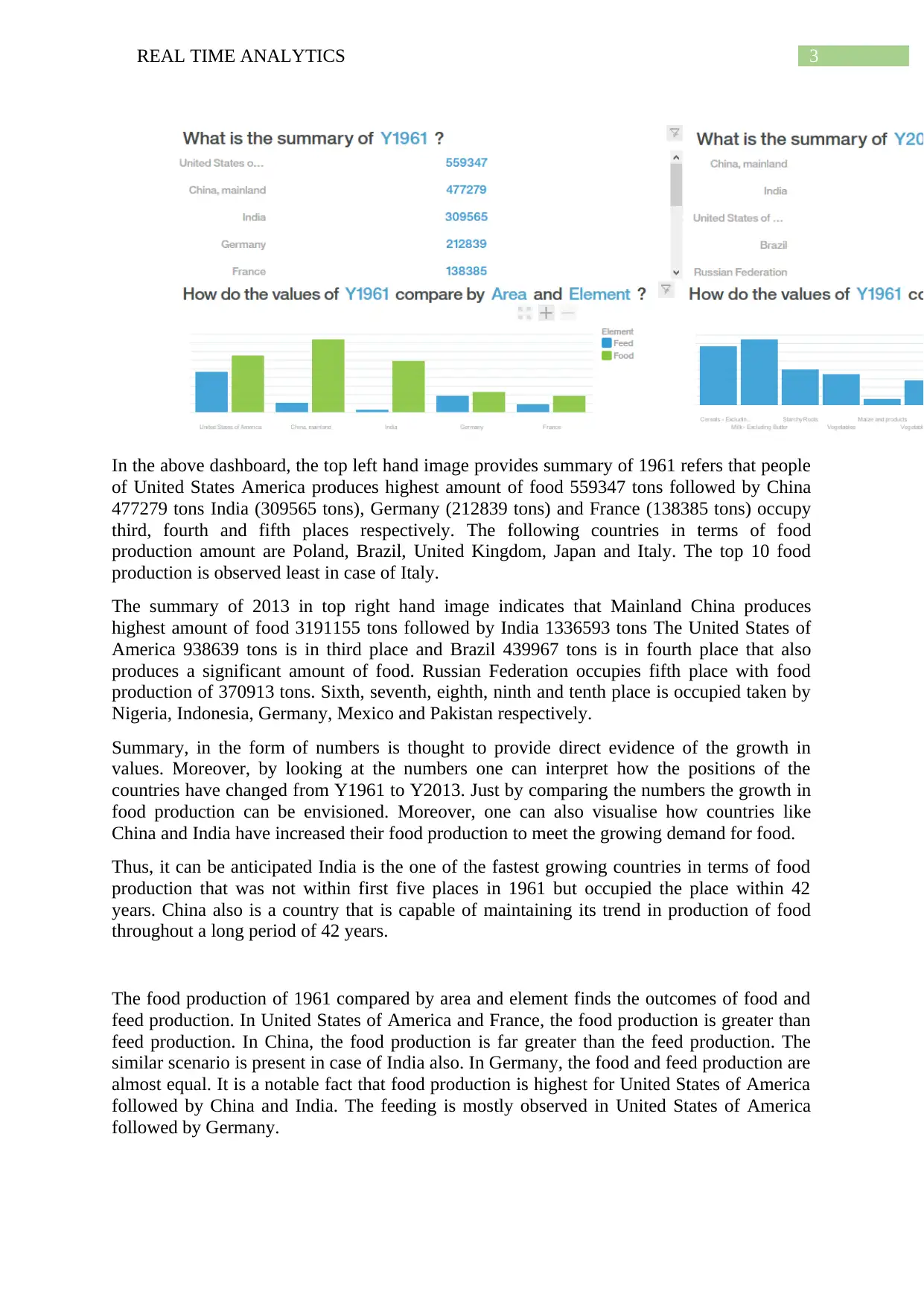
3REAL TIME ANALYTICS
In the above dashboard, the top left hand image provides summary of 1961 refers that people
of United States America produces highest amount of food 559347 tons followed by China
477279 tons India (309565 tons), Germany (212839 tons) and France (138385 tons) occupy
third, fourth and fifth places respectively. The following countries in terms of food
production amount are Poland, Brazil, United Kingdom, Japan and Italy. The top 10 food
production is observed least in case of Italy.
The summary of 2013 in top right hand image indicates that Mainland China produces
highest amount of food 3191155 tons followed by India 1336593 tons The United States of
America 938639 tons is in third place and Brazil 439967 tons is in fourth place that also
produces a significant amount of food. Russian Federation occupies fifth place with food
production of 370913 tons. Sixth, seventh, eighth, ninth and tenth place is occupied taken by
Nigeria, Indonesia, Germany, Mexico and Pakistan respectively.
Summary, in the form of numbers is thought to provide direct evidence of the growth in
values. Moreover, by looking at the numbers one can interpret how the positions of the
countries have changed from Y1961 to Y2013. Just by comparing the numbers the growth in
food production can be envisioned. Moreover, one can also visualise how countries like
China and India have increased their food production to meet the growing demand for food.
Thus, it can be anticipated India is the one of the fastest growing countries in terms of food
production that was not within first five places in 1961 but occupied the place within 42
years. China also is a country that is capable of maintaining its trend in production of food
throughout a long period of 42 years.
The food production of 1961 compared by area and element finds the outcomes of food and
feed production. In United States of America and France, the food production is greater than
feed production. In China, the food production is far greater than the feed production. The
similar scenario is present in case of India also. In Germany, the food and feed production are
almost equal. It is a notable fact that food production is highest for United States of America
followed by China and India. The feeding is mostly observed in United States of America
followed by Germany.
In the above dashboard, the top left hand image provides summary of 1961 refers that people
of United States America produces highest amount of food 559347 tons followed by China
477279 tons India (309565 tons), Germany (212839 tons) and France (138385 tons) occupy
third, fourth and fifth places respectively. The following countries in terms of food
production amount are Poland, Brazil, United Kingdom, Japan and Italy. The top 10 food
production is observed least in case of Italy.
The summary of 2013 in top right hand image indicates that Mainland China produces
highest amount of food 3191155 tons followed by India 1336593 tons The United States of
America 938639 tons is in third place and Brazil 439967 tons is in fourth place that also
produces a significant amount of food. Russian Federation occupies fifth place with food
production of 370913 tons. Sixth, seventh, eighth, ninth and tenth place is occupied taken by
Nigeria, Indonesia, Germany, Mexico and Pakistan respectively.
Summary, in the form of numbers is thought to provide direct evidence of the growth in
values. Moreover, by looking at the numbers one can interpret how the positions of the
countries have changed from Y1961 to Y2013. Just by comparing the numbers the growth in
food production can be envisioned. Moreover, one can also visualise how countries like
China and India have increased their food production to meet the growing demand for food.
Thus, it can be anticipated India is the one of the fastest growing countries in terms of food
production that was not within first five places in 1961 but occupied the place within 42
years. China also is a country that is capable of maintaining its trend in production of food
throughout a long period of 42 years.
The food production of 1961 compared by area and element finds the outcomes of food and
feed production. In United States of America and France, the food production is greater than
feed production. In China, the food production is far greater than the feed production. The
similar scenario is present in case of India also. In Germany, the food and feed production are
almost equal. It is a notable fact that food production is highest for United States of America
followed by China and India. The feeding is mostly observed in United States of America
followed by Germany.
Secure Best Marks with AI Grader
Need help grading? Try our AI Grader for instant feedback on your assignments.

4REAL TIME ANALYTICS
Bar chart here has been used to compare the food and feed production. The visualization of
the height of the bar provides an estimate of the difference not only between countries but
also between food and feed.
The bottom left hand image shows a comparison of food productions in Y1961. This is
important since we need to compare the nature of food productions in Y1961. In addition, the
analysis also can be used to understand how food productions have changed according to the
need of the population. the bar chart depicts that Milk (Excluding Bar) was the highest
produce in Y 1961 followed by Cereals and Starchy Roots. The 10th most important item
being produced was Fruits.
The above image provides a comparison of the food productions in Y2013. A
comparison of the above image with Y1961 shows that the top food production throughout
the world still remains Milk (Excluding Butter) followed by Cereals (Excluding Beer).
However, the third most important food producing item in Y2013 is vegetables as compared
to starchy roots in Y1961. In addition, it is also found that while Meat and Meat products
were not in the top 10 highest producing items in Y1961, it has found a place in Y2013.
The food is produced in mainly bottom five sectors in 2013 that are Antigua and Barbuda,
Grenada, Bermuda, Kiribati as well as Saint Kitts and Nevis. The food production in the
selected bottom 5 sectors depict that-
The production of Antigua and Barbuda has decreased from 180 million tons to below 120
million tons. The food production of Granada has decreased from more than 140 million tons
to almost 120 million. The food production of Bermuda has decreased from 135 million tons
to almost 105 million tons. In Kiribati, the food production is much higher in 2013 than 1961.
In Saint Kitts and Nevis, the overall food production is almost same as 1961 in 2013.
Bar chart here has been used to compare the food and feed production. The visualization of
the height of the bar provides an estimate of the difference not only between countries but
also between food and feed.
The bottom left hand image shows a comparison of food productions in Y1961. This is
important since we need to compare the nature of food productions in Y1961. In addition, the
analysis also can be used to understand how food productions have changed according to the
need of the population. the bar chart depicts that Milk (Excluding Bar) was the highest
produce in Y 1961 followed by Cereals and Starchy Roots. The 10th most important item
being produced was Fruits.
The above image provides a comparison of the food productions in Y2013. A
comparison of the above image with Y1961 shows that the top food production throughout
the world still remains Milk (Excluding Butter) followed by Cereals (Excluding Beer).
However, the third most important food producing item in Y2013 is vegetables as compared
to starchy roots in Y1961. In addition, it is also found that while Meat and Meat products
were not in the top 10 highest producing items in Y1961, it has found a place in Y2013.
The food is produced in mainly bottom five sectors in 2013 that are Antigua and Barbuda,
Grenada, Bermuda, Kiribati as well as Saint Kitts and Nevis. The food production in the
selected bottom 5 sectors depict that-
The production of Antigua and Barbuda has decreased from 180 million tons to below 120
million tons. The food production of Granada has decreased from more than 140 million tons
to almost 120 million. The food production of Bermuda has decreased from 135 million tons
to almost 105 million tons. In Kiribati, the food production is much higher in 2013 than 1961.
In Saint Kitts and Nevis, the overall food production is almost same as 1961 in 2013.
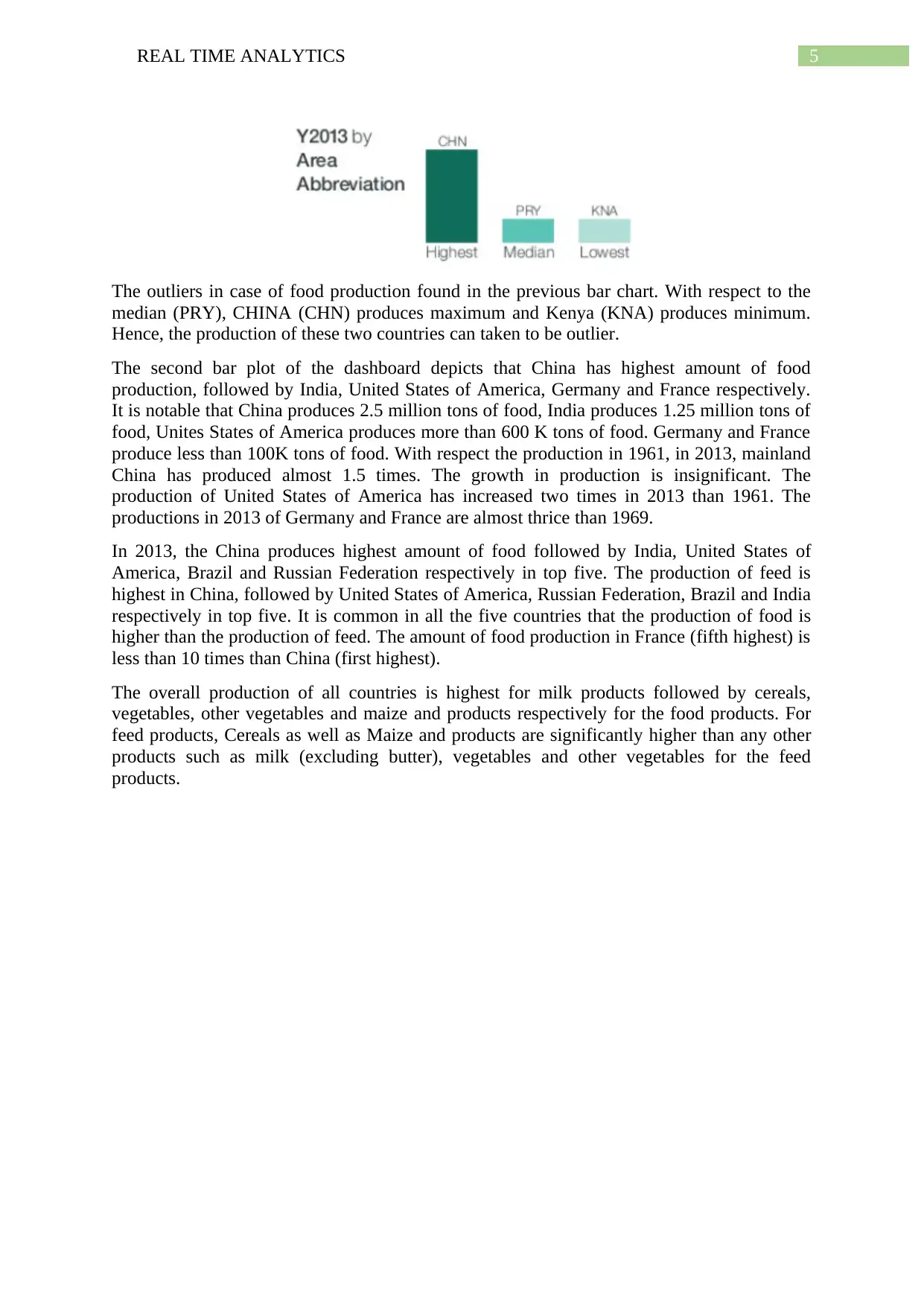
5REAL TIME ANALYTICS
The outliers in case of food production found in the previous bar chart. With respect to the
median (PRY), CHINA (CHN) produces maximum and Kenya (KNA) produces minimum.
Hence, the production of these two countries can taken to be outlier.
The second bar plot of the dashboard depicts that China has highest amount of food
production, followed by India, United States of America, Germany and France respectively.
It is notable that China produces 2.5 million tons of food, India produces 1.25 million tons of
food, Unites States of America produces more than 600 K tons of food. Germany and France
produce less than 100K tons of food. With respect the production in 1961, in 2013, mainland
China has produced almost 1.5 times. The growth in production is insignificant. The
production of United States of America has increased two times in 2013 than 1961. The
productions in 2013 of Germany and France are almost thrice than 1969.
In 2013, the China produces highest amount of food followed by India, United States of
America, Brazil and Russian Federation respectively in top five. The production of feed is
highest in China, followed by United States of America, Russian Federation, Brazil and India
respectively in top five. It is common in all the five countries that the production of food is
higher than the production of feed. The amount of food production in France (fifth highest) is
less than 10 times than China (first highest).
The overall production of all countries is highest for milk products followed by cereals,
vegetables, other vegetables and maize and products respectively for the food products. For
feed products, Cereals as well as Maize and products are significantly higher than any other
products such as milk (excluding butter), vegetables and other vegetables for the feed
products.
The outliers in case of food production found in the previous bar chart. With respect to the
median (PRY), CHINA (CHN) produces maximum and Kenya (KNA) produces minimum.
Hence, the production of these two countries can taken to be outlier.
The second bar plot of the dashboard depicts that China has highest amount of food
production, followed by India, United States of America, Germany and France respectively.
It is notable that China produces 2.5 million tons of food, India produces 1.25 million tons of
food, Unites States of America produces more than 600 K tons of food. Germany and France
produce less than 100K tons of food. With respect the production in 1961, in 2013, mainland
China has produced almost 1.5 times. The growth in production is insignificant. The
production of United States of America has increased two times in 2013 than 1961. The
productions in 2013 of Germany and France are almost thrice than 1969.
In 2013, the China produces highest amount of food followed by India, United States of
America, Brazil and Russian Federation respectively in top five. The production of feed is
highest in China, followed by United States of America, Russian Federation, Brazil and India
respectively in top five. It is common in all the five countries that the production of food is
higher than the production of feed. The amount of food production in France (fifth highest) is
less than 10 times than China (first highest).
The overall production of all countries is highest for milk products followed by cereals,
vegetables, other vegetables and maize and products respectively for the food products. For
feed products, Cereals as well as Maize and products are significantly higher than any other
products such as milk (excluding butter), vegetables and other vegetables for the feed
products.
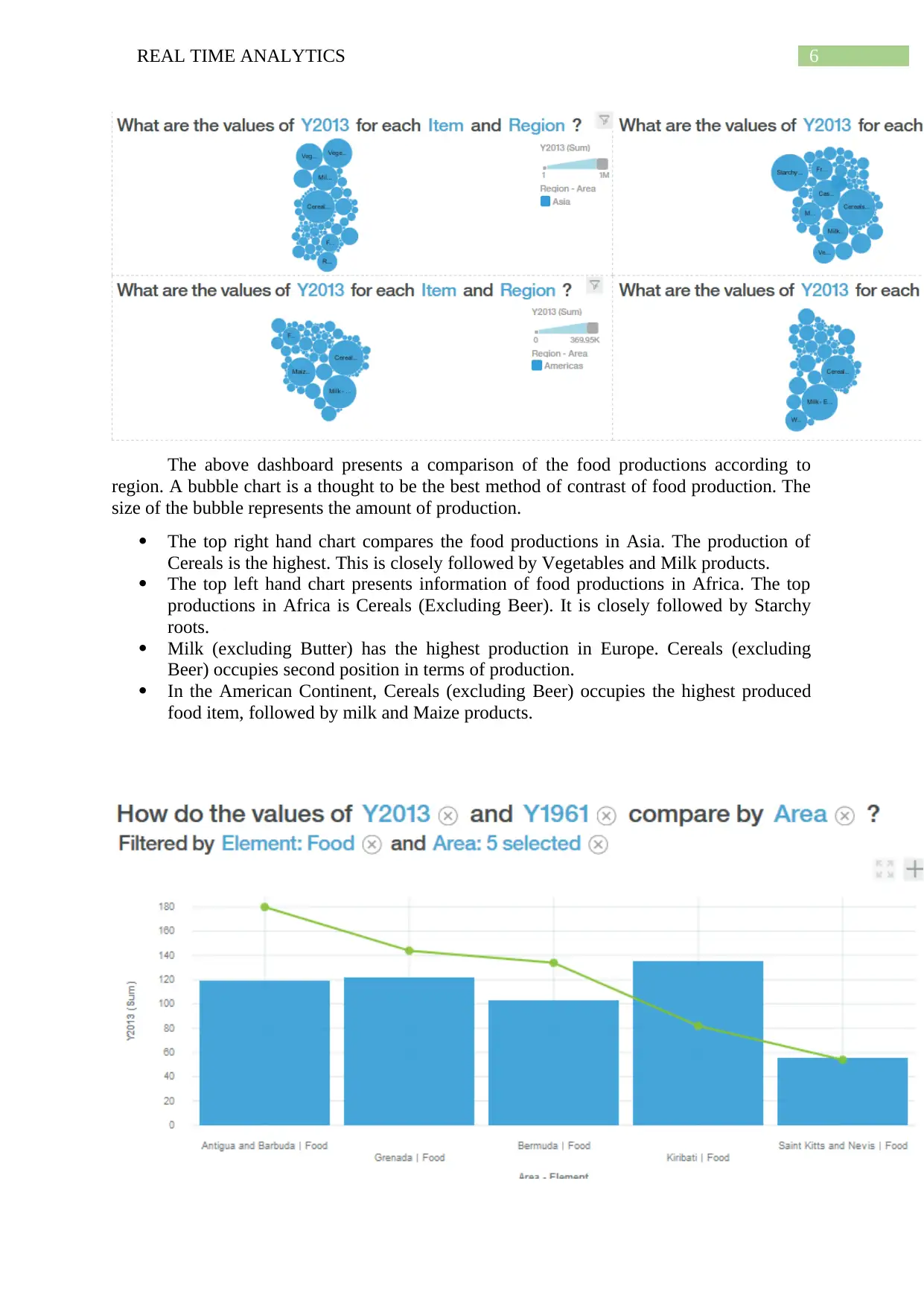
6REAL TIME ANALYTICS
The above dashboard presents a comparison of the food productions according to
region. A bubble chart is a thought to be the best method of contrast of food production. The
size of the bubble represents the amount of production.
The top right hand chart compares the food productions in Asia. The production of
Cereals is the highest. This is closely followed by Vegetables and Milk products.
The top left hand chart presents information of food productions in Africa. The top
productions in Africa is Cereals (Excluding Beer). It is closely followed by Starchy
roots.
Milk (excluding Butter) has the highest production in Europe. Cereals (excluding
Beer) occupies second position in terms of production.
In the American Continent, Cereals (excluding Beer) occupies the highest produced
food item, followed by milk and Maize products.
The above dashboard presents a comparison of the food productions according to
region. A bubble chart is a thought to be the best method of contrast of food production. The
size of the bubble represents the amount of production.
The top right hand chart compares the food productions in Asia. The production of
Cereals is the highest. This is closely followed by Vegetables and Milk products.
The top left hand chart presents information of food productions in Africa. The top
productions in Africa is Cereals (Excluding Beer). It is closely followed by Starchy
roots.
Milk (excluding Butter) has the highest production in Europe. Cereals (excluding
Beer) occupies second position in terms of production.
In the American Continent, Cereals (excluding Beer) occupies the highest produced
food item, followed by milk and Maize products.
Paraphrase This Document
Need a fresh take? Get an instant paraphrase of this document with our AI Paraphraser
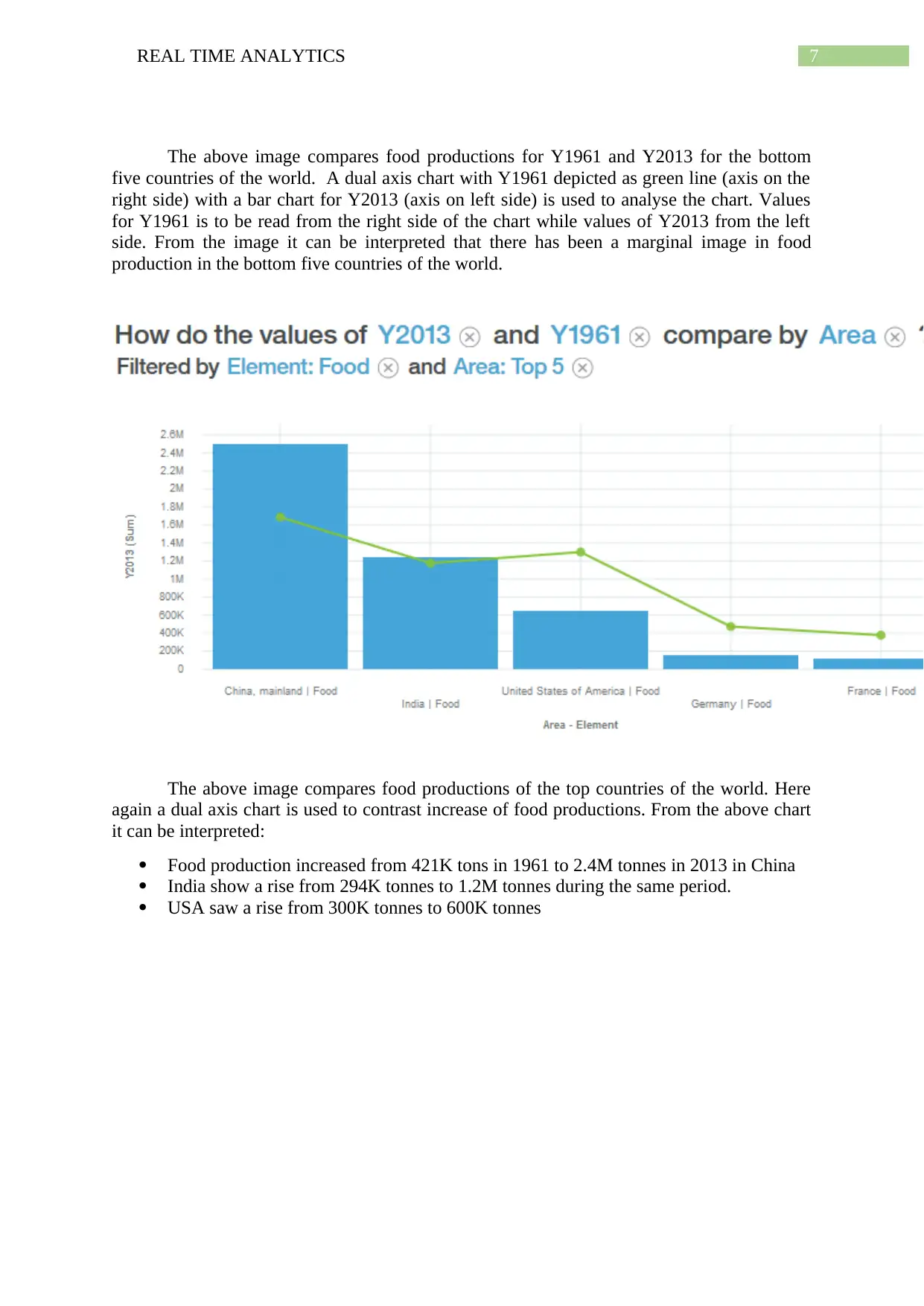
7REAL TIME ANALYTICS
The above image compares food productions for Y1961 and Y2013 for the bottom
five countries of the world. A dual axis chart with Y1961 depicted as green line (axis on the
right side) with a bar chart for Y2013 (axis on left side) is used to analyse the chart. Values
for Y1961 is to be read from the right side of the chart while values of Y2013 from the left
side. From the image it can be interpreted that there has been a marginal image in food
production in the bottom five countries of the world.
The above image compares food productions of the top countries of the world. Here
again a dual axis chart is used to contrast increase of food productions. From the above chart
it can be interpreted:
Food production increased from 421K tons in 1961 to 2.4M tonnes in 2013 in China
India show a rise from 294K tonnes to 1.2M tonnes during the same period.
USA saw a rise from 300K tonnes to 600K tonnes
The above image compares food productions for Y1961 and Y2013 for the bottom
five countries of the world. A dual axis chart with Y1961 depicted as green line (axis on the
right side) with a bar chart for Y2013 (axis on left side) is used to analyse the chart. Values
for Y1961 is to be read from the right side of the chart while values of Y2013 from the left
side. From the image it can be interpreted that there has been a marginal image in food
production in the bottom five countries of the world.
The above image compares food productions of the top countries of the world. Here
again a dual axis chart is used to contrast increase of food productions. From the above chart
it can be interpreted:
Food production increased from 421K tons in 1961 to 2.4M tonnes in 2013 in China
India show a rise from 294K tonnes to 1.2M tonnes during the same period.
USA saw a rise from 300K tonnes to 600K tonnes
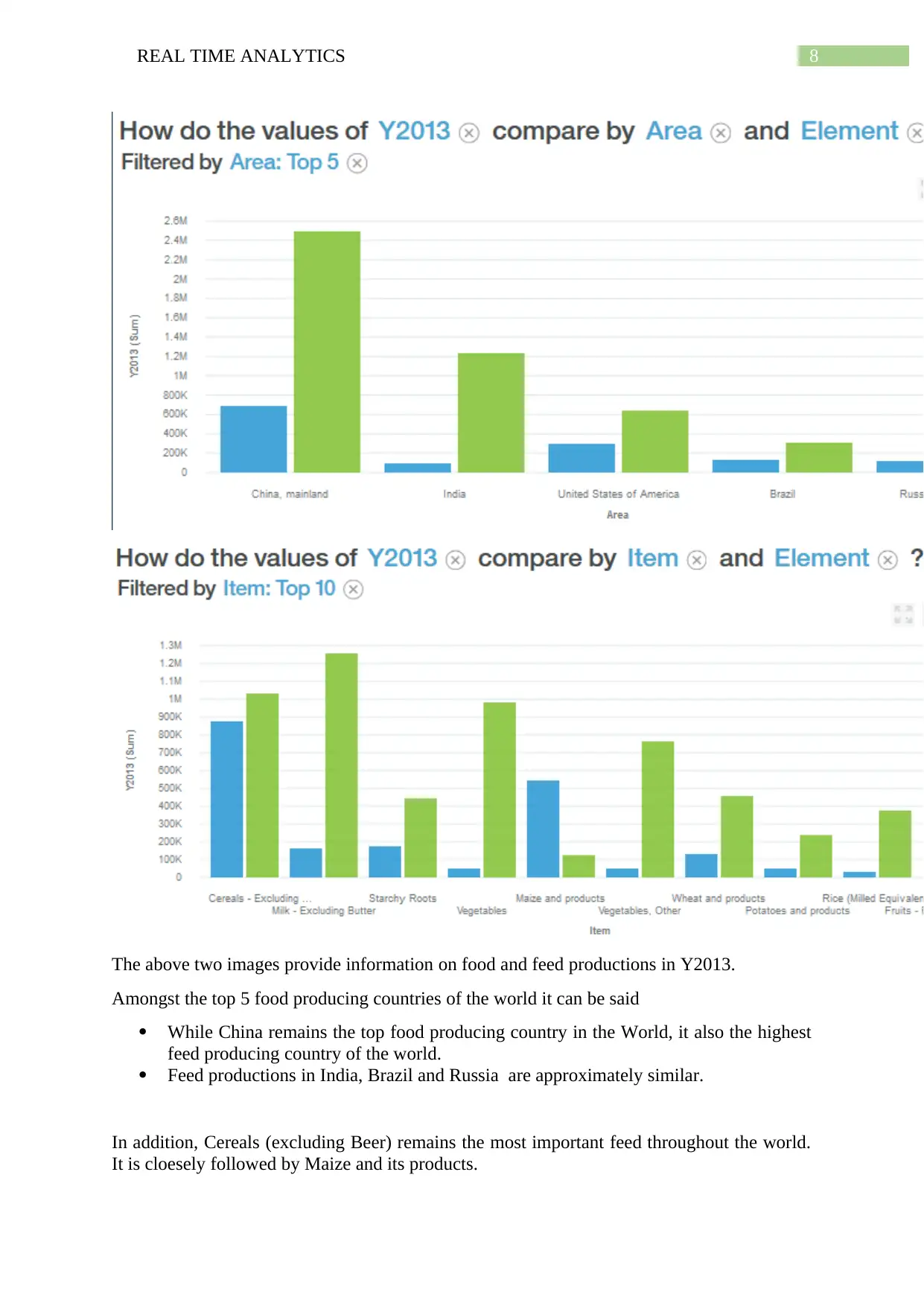
8REAL TIME ANALYTICS
The above two images provide information on food and feed productions in Y2013.
Amongst the top 5 food producing countries of the world it can be said
While China remains the top food producing country in the World, it also the highest
feed producing country of the world.
Feed productions in India, Brazil and Russia are approximately similar.
In addition, Cereals (excluding Beer) remains the most important feed throughout the world.
It is cloesely followed by Maize and its products.
The above two images provide information on food and feed productions in Y2013.
Amongst the top 5 food producing countries of the world it can be said
While China remains the top food producing country in the World, it also the highest
feed producing country of the world.
Feed productions in India, Brazil and Russia are approximately similar.
In addition, Cereals (excluding Beer) remains the most important feed throughout the world.
It is cloesely followed by Maize and its products.
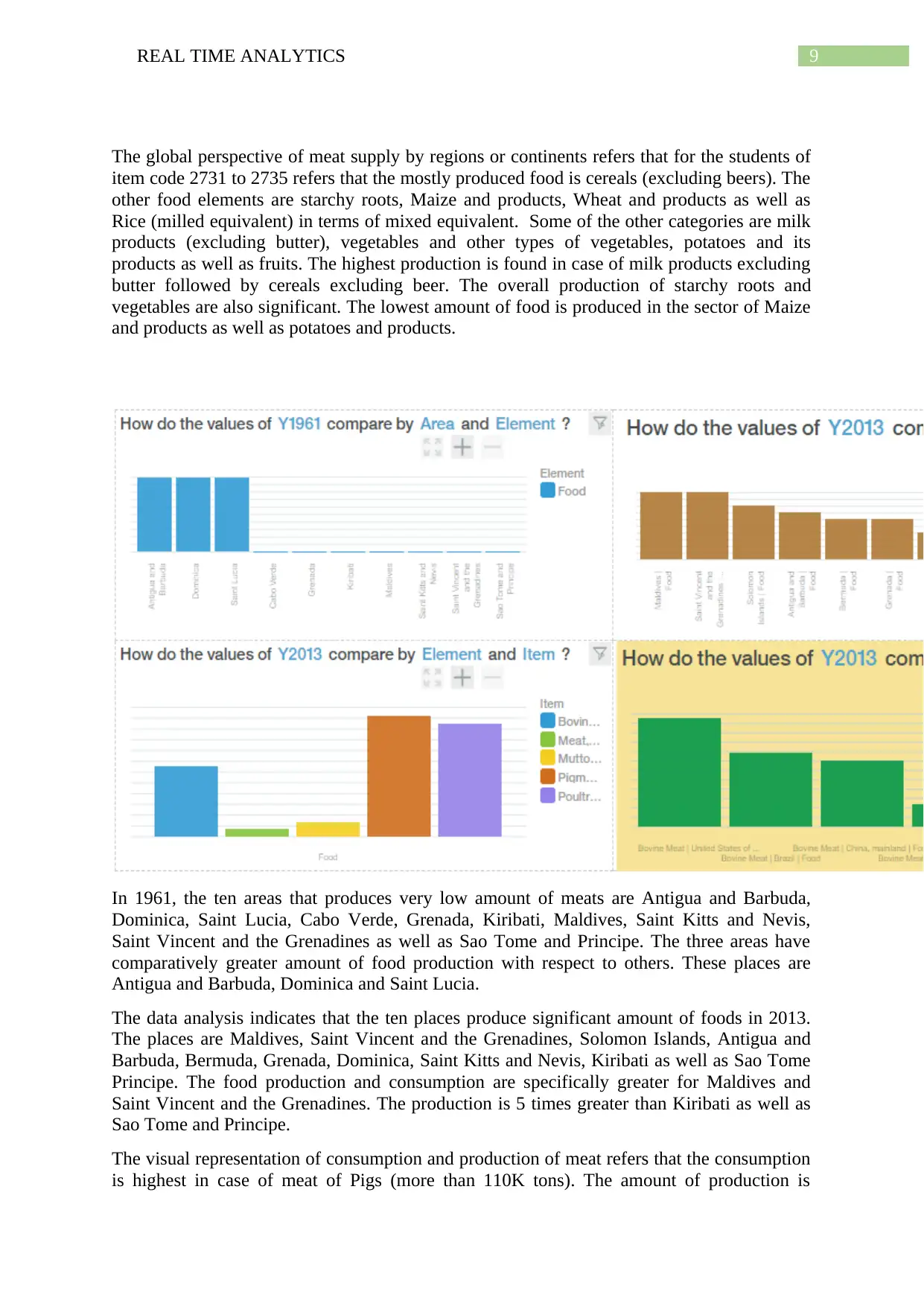
9REAL TIME ANALYTICS
The global perspective of meat supply by regions or continents refers that for the students of
item code 2731 to 2735 refers that the mostly produced food is cereals (excluding beers). The
other food elements are starchy roots, Maize and products, Wheat and products as well as
Rice (milled equivalent) in terms of mixed equivalent. Some of the other categories are milk
products (excluding butter), vegetables and other types of vegetables, potatoes and its
products as well as fruits. The highest production is found in case of milk products excluding
butter followed by cereals excluding beer. The overall production of starchy roots and
vegetables are also significant. The lowest amount of food is produced in the sector of Maize
and products as well as potatoes and products.
In 1961, the ten areas that produces very low amount of meats are Antigua and Barbuda,
Dominica, Saint Lucia, Cabo Verde, Grenada, Kiribati, Maldives, Saint Kitts and Nevis,
Saint Vincent and the Grenadines as well as Sao Tome and Principe. The three areas have
comparatively greater amount of food production with respect to others. These places are
Antigua and Barbuda, Dominica and Saint Lucia.
The data analysis indicates that the ten places produce significant amount of foods in 2013.
The places are Maldives, Saint Vincent and the Grenadines, Solomon Islands, Antigua and
Barbuda, Bermuda, Grenada, Dominica, Saint Kitts and Nevis, Kiribati as well as Sao Tome
Principe. The food production and consumption are specifically greater for Maldives and
Saint Vincent and the Grenadines. The production is 5 times greater than Kiribati as well as
Sao Tome and Principe.
The visual representation of consumption and production of meat refers that the consumption
is highest in case of meat of Pigs (more than 110K tons). The amount of production is
The global perspective of meat supply by regions or continents refers that for the students of
item code 2731 to 2735 refers that the mostly produced food is cereals (excluding beers). The
other food elements are starchy roots, Maize and products, Wheat and products as well as
Rice (milled equivalent) in terms of mixed equivalent. Some of the other categories are milk
products (excluding butter), vegetables and other types of vegetables, potatoes and its
products as well as fruits. The highest production is found in case of milk products excluding
butter followed by cereals excluding beer. The overall production of starchy roots and
vegetables are also significant. The lowest amount of food is produced in the sector of Maize
and products as well as potatoes and products.
In 1961, the ten areas that produces very low amount of meats are Antigua and Barbuda,
Dominica, Saint Lucia, Cabo Verde, Grenada, Kiribati, Maldives, Saint Kitts and Nevis,
Saint Vincent and the Grenadines as well as Sao Tome and Principe. The three areas have
comparatively greater amount of food production with respect to others. These places are
Antigua and Barbuda, Dominica and Saint Lucia.
The data analysis indicates that the ten places produce significant amount of foods in 2013.
The places are Maldives, Saint Vincent and the Grenadines, Solomon Islands, Antigua and
Barbuda, Bermuda, Grenada, Dominica, Saint Kitts and Nevis, Kiribati as well as Sao Tome
Principe. The food production and consumption are specifically greater for Maldives and
Saint Vincent and the Grenadines. The production is 5 times greater than Kiribati as well as
Sao Tome and Principe.
The visual representation of consumption and production of meat refers that the consumption
is highest in case of meat of Pigs (more than 110K tons). The amount of production is
Secure Best Marks with AI Grader
Need help grading? Try our AI Grader for instant feedback on your assignments.
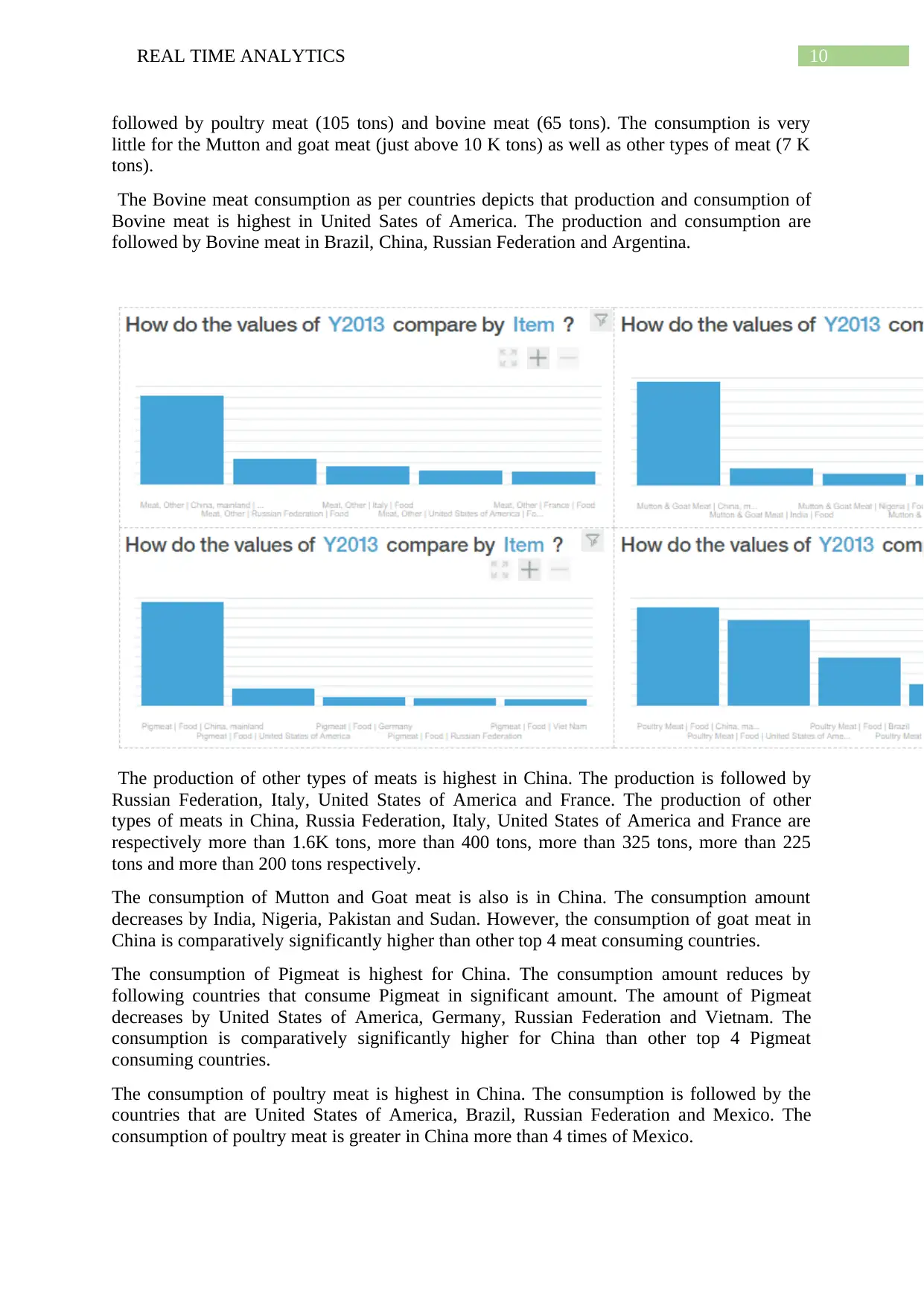
10REAL TIME ANALYTICS
followed by poultry meat (105 tons) and bovine meat (65 tons). The consumption is very
little for the Mutton and goat meat (just above 10 K tons) as well as other types of meat (7 K
tons).
The Bovine meat consumption as per countries depicts that production and consumption of
Bovine meat is highest in United Sates of America. The production and consumption are
followed by Bovine meat in Brazil, China, Russian Federation and Argentina.
The production of other types of meats is highest in China. The production is followed by
Russian Federation, Italy, United States of America and France. The production of other
types of meats in China, Russia Federation, Italy, United States of America and France are
respectively more than 1.6K tons, more than 400 tons, more than 325 tons, more than 225
tons and more than 200 tons respectively.
The consumption of Mutton and Goat meat is also is in China. The consumption amount
decreases by India, Nigeria, Pakistan and Sudan. However, the consumption of goat meat in
China is comparatively significantly higher than other top 4 meat consuming countries.
The consumption of Pigmeat is highest for China. The consumption amount reduces by
following countries that consume Pigmeat in significant amount. The amount of Pigmeat
decreases by United States of America, Germany, Russian Federation and Vietnam. The
consumption is comparatively significantly higher for China than other top 4 Pigmeat
consuming countries.
The consumption of poultry meat is highest in China. The consumption is followed by the
countries that are United States of America, Brazil, Russian Federation and Mexico. The
consumption of poultry meat is greater in China more than 4 times of Mexico.
followed by poultry meat (105 tons) and bovine meat (65 tons). The consumption is very
little for the Mutton and goat meat (just above 10 K tons) as well as other types of meat (7 K
tons).
The Bovine meat consumption as per countries depicts that production and consumption of
Bovine meat is highest in United Sates of America. The production and consumption are
followed by Bovine meat in Brazil, China, Russian Federation and Argentina.
The production of other types of meats is highest in China. The production is followed by
Russian Federation, Italy, United States of America and France. The production of other
types of meats in China, Russia Federation, Italy, United States of America and France are
respectively more than 1.6K tons, more than 400 tons, more than 325 tons, more than 225
tons and more than 200 tons respectively.
The consumption of Mutton and Goat meat is also is in China. The consumption amount
decreases by India, Nigeria, Pakistan and Sudan. However, the consumption of goat meat in
China is comparatively significantly higher than other top 4 meat consuming countries.
The consumption of Pigmeat is highest for China. The consumption amount reduces by
following countries that consume Pigmeat in significant amount. The amount of Pigmeat
decreases by United States of America, Germany, Russian Federation and Vietnam. The
consumption is comparatively significantly higher for China than other top 4 Pigmeat
consuming countries.
The consumption of poultry meat is highest in China. The consumption is followed by the
countries that are United States of America, Brazil, Russian Federation and Mexico. The
consumption of poultry meat is greater in China more than 4 times of Mexico.

11REAL TIME ANALYTICS
The longitudinal plot of two types of meat (Bovine meat and Poultry meat) indicates that
these types of meats are mostly consumed in United States of America and Alaska. The meat
is consumed with moderate amount in Brazil, Kiribati and Russian Federation. The meat is
also consumed in India, Indonesia, Canada and Kiribati.
Recommendations for CEO
Recommendation 1: Use of Sustainable Intensification of Food productions
The longitudinal plot of two types of meat (Bovine meat and Poultry meat) indicates that
these types of meats are mostly consumed in United States of America and Alaska. The meat
is consumed with moderate amount in Brazil, Kiribati and Russian Federation. The meat is
also consumed in India, Indonesia, Canada and Kiribati.
Recommendations for CEO
Recommendation 1: Use of Sustainable Intensification of Food productions

12REAL TIME ANALYTICS
The above chart compares food productions for top and bottom 10 producers. A
comparison of the productions between Y1961 and Y2013 shows that there is a huge gap
between the highest and lowest food producers.
In order to double the food productions by 2050 one approach might be “sustainable
intensification” of growth of food products (Garnett et al., 2013). This would ensure less
impact on environment, keeping in view that major crop productions are a major source of
Green House Gases. Further, increase in production of arable crops would benefit production
in the face of resource scarcity. Moreover, increasing the food production capacity in less
developed countries would require sustained improvement in finances, human capital and
physical labour.
Recommendation 2: Increase in food diversity in different regions of the World
Cereals account for major food productions in all regions of the world. Investigation into
food production shows that there has been a dearth of food diversity throughout different
region of the world.
Research indicates food production can be increased through diversity (Khoury et al., 2014).
There is a similarity in food productions throughout the world. This has occurred due to
interdependence of countries on food productions. However, growing similar types of crops
possess huge ecology danger. Food diversity can contribute to increased production of food
with varied food values.
Recommendation 3: Increase in production of Meat based products
The production of meat based products has just seen its entry in the top 10 food products. In
Y1961 meat and meat based products were not in the top 10 list of foods being produced.
However, in the Y2013 they have found a place. Increase in meat based products can be an
easy resource to doubling food capacity. Moreover, mean based products have a high
nutritional value and can play an important role in the fight against hunger (Tomlinson,
2013).
The above chart compares food productions for top and bottom 10 producers. A
comparison of the productions between Y1961 and Y2013 shows that there is a huge gap
between the highest and lowest food producers.
In order to double the food productions by 2050 one approach might be “sustainable
intensification” of growth of food products (Garnett et al., 2013). This would ensure less
impact on environment, keeping in view that major crop productions are a major source of
Green House Gases. Further, increase in production of arable crops would benefit production
in the face of resource scarcity. Moreover, increasing the food production capacity in less
developed countries would require sustained improvement in finances, human capital and
physical labour.
Recommendation 2: Increase in food diversity in different regions of the World
Cereals account for major food productions in all regions of the world. Investigation into
food production shows that there has been a dearth of food diversity throughout different
region of the world.
Research indicates food production can be increased through diversity (Khoury et al., 2014).
There is a similarity in food productions throughout the world. This has occurred due to
interdependence of countries on food productions. However, growing similar types of crops
possess huge ecology danger. Food diversity can contribute to increased production of food
with varied food values.
Recommendation 3: Increase in production of Meat based products
The production of meat based products has just seen its entry in the top 10 food products. In
Y1961 meat and meat based products were not in the top 10 list of foods being produced.
However, in the Y2013 they have found a place. Increase in meat based products can be an
easy resource to doubling food capacity. Moreover, mean based products have a high
nutritional value and can play an important role in the fight against hunger (Tomlinson,
2013).
Paraphrase This Document
Need a fresh take? Get an instant paraphrase of this document with our AI Paraphraser
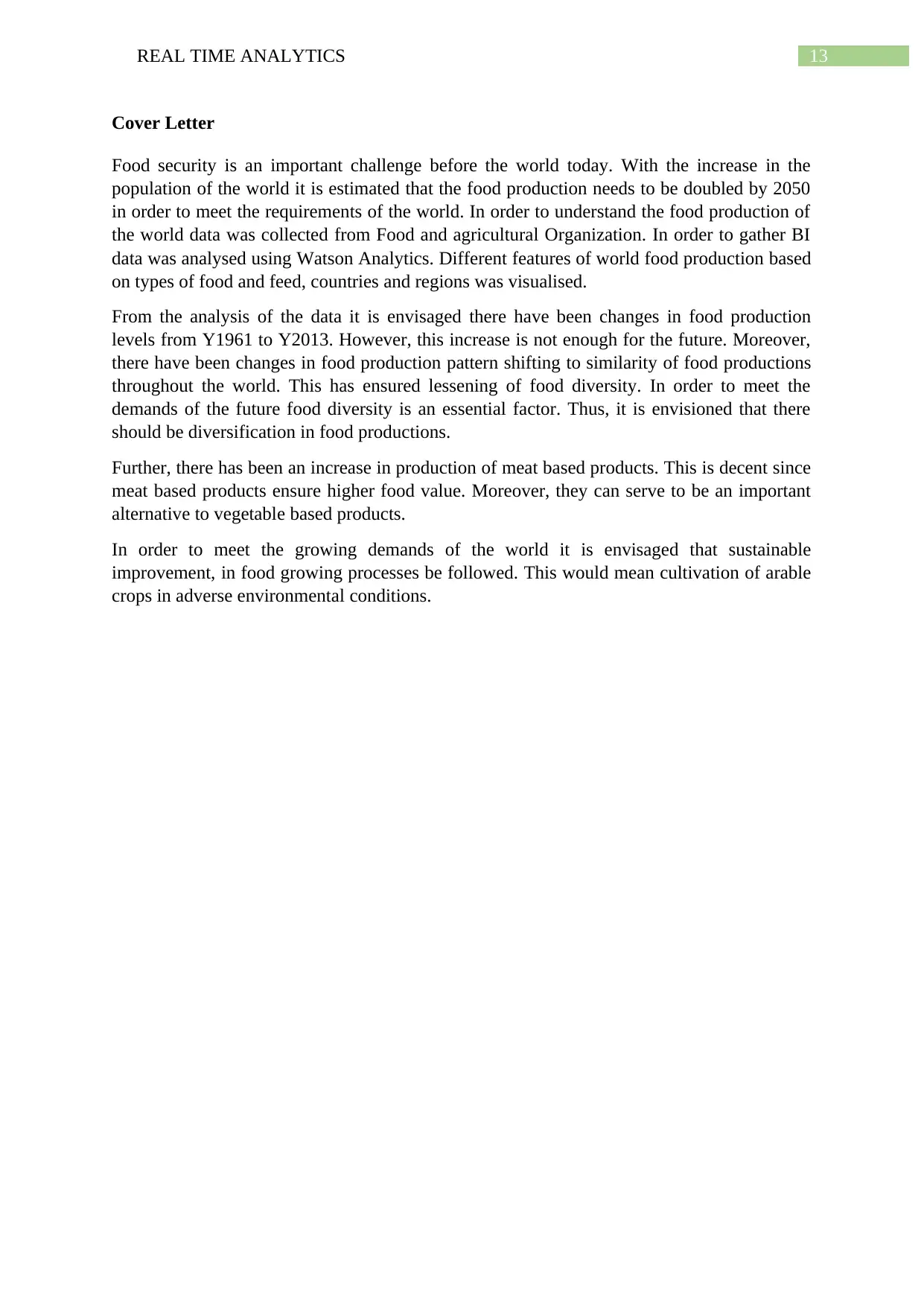
13REAL TIME ANALYTICS
Cover Letter
Food security is an important challenge before the world today. With the increase in the
population of the world it is estimated that the food production needs to be doubled by 2050
in order to meet the requirements of the world. In order to understand the food production of
the world data was collected from Food and agricultural Organization. In order to gather BI
data was analysed using Watson Analytics. Different features of world food production based
on types of food and feed, countries and regions was visualised.
From the analysis of the data it is envisaged there have been changes in food production
levels from Y1961 to Y2013. However, this increase is not enough for the future. Moreover,
there have been changes in food production pattern shifting to similarity of food productions
throughout the world. This has ensured lessening of food diversity. In order to meet the
demands of the future food diversity is an essential factor. Thus, it is envisioned that there
should be diversification in food productions.
Further, there has been an increase in production of meat based products. This is decent since
meat based products ensure higher food value. Moreover, they can serve to be an important
alternative to vegetable based products.
In order to meet the growing demands of the world it is envisaged that sustainable
improvement, in food growing processes be followed. This would mean cultivation of arable
crops in adverse environmental conditions.
Cover Letter
Food security is an important challenge before the world today. With the increase in the
population of the world it is estimated that the food production needs to be doubled by 2050
in order to meet the requirements of the world. In order to understand the food production of
the world data was collected from Food and agricultural Organization. In order to gather BI
data was analysed using Watson Analytics. Different features of world food production based
on types of food and feed, countries and regions was visualised.
From the analysis of the data it is envisaged there have been changes in food production
levels from Y1961 to Y2013. However, this increase is not enough for the future. Moreover,
there have been changes in food production pattern shifting to similarity of food productions
throughout the world. This has ensured lessening of food diversity. In order to meet the
demands of the future food diversity is an essential factor. Thus, it is envisioned that there
should be diversification in food productions.
Further, there has been an increase in production of meat based products. This is decent since
meat based products ensure higher food value. Moreover, they can serve to be an important
alternative to vegetable based products.
In order to meet the growing demands of the world it is envisaged that sustainable
improvement, in food growing processes be followed. This would mean cultivation of arable
crops in adverse environmental conditions.
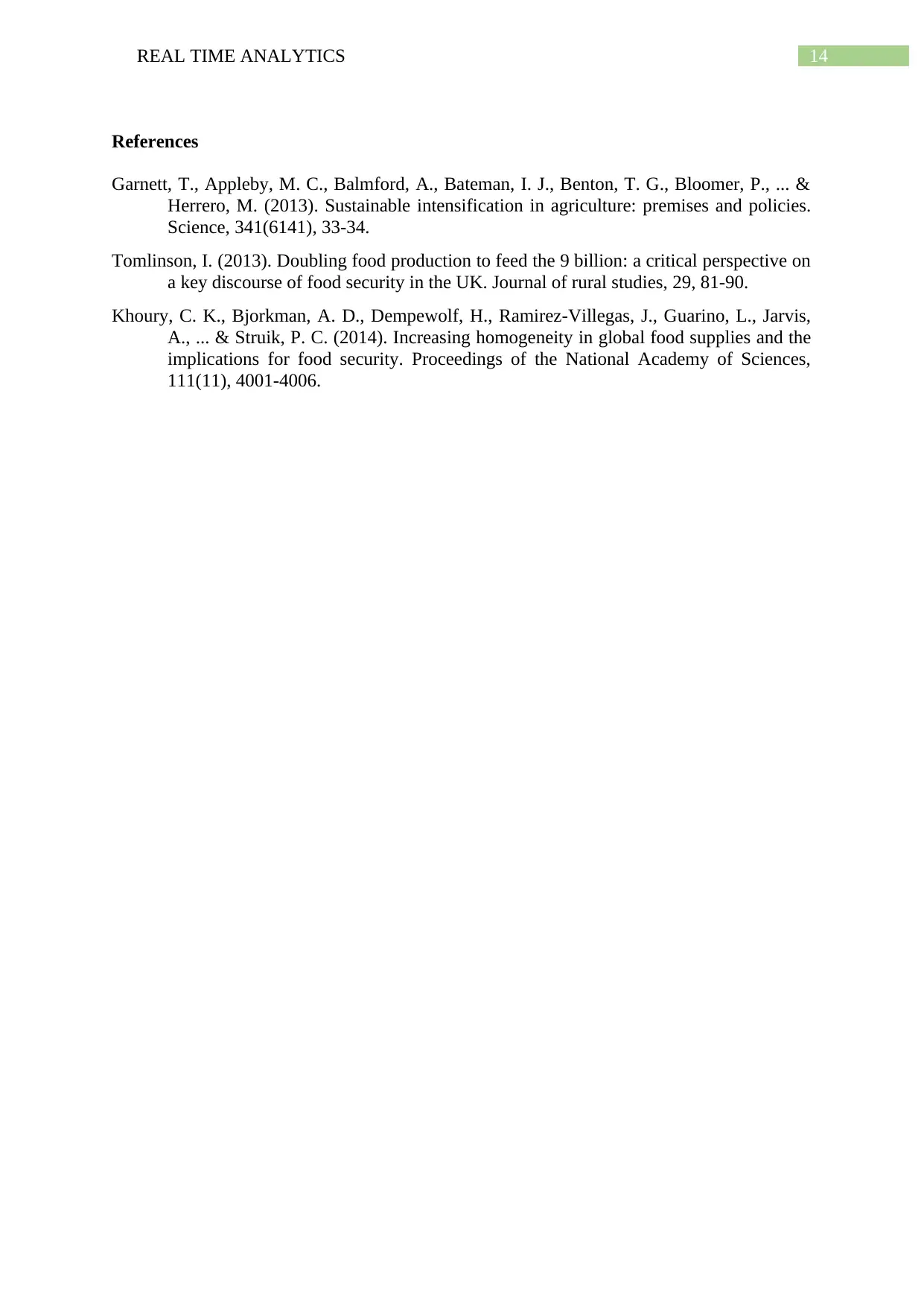
14REAL TIME ANALYTICS
References
Garnett, T., Appleby, M. C., Balmford, A., Bateman, I. J., Benton, T. G., Bloomer, P., ... &
Herrero, M. (2013). Sustainable intensification in agriculture: premises and policies.
Science, 341(6141), 33-34.
Tomlinson, I. (2013). Doubling food production to feed the 9 billion: a critical perspective on
a key discourse of food security in the UK. Journal of rural studies, 29, 81-90.
Khoury, C. K., Bjorkman, A. D., Dempewolf, H., Ramirez-Villegas, J., Guarino, L., Jarvis,
A., ... & Struik, P. C. (2014). Increasing homogeneity in global food supplies and the
implications for food security. Proceedings of the National Academy of Sciences,
111(11), 4001-4006.
References
Garnett, T., Appleby, M. C., Balmford, A., Bateman, I. J., Benton, T. G., Bloomer, P., ... &
Herrero, M. (2013). Sustainable intensification in agriculture: premises and policies.
Science, 341(6141), 33-34.
Tomlinson, I. (2013). Doubling food production to feed the 9 billion: a critical perspective on
a key discourse of food security in the UK. Journal of rural studies, 29, 81-90.
Khoury, C. K., Bjorkman, A. D., Dempewolf, H., Ramirez-Villegas, J., Guarino, L., Jarvis,
A., ... & Struik, P. C. (2014). Increasing homogeneity in global food supplies and the
implications for food security. Proceedings of the National Academy of Sciences,
111(11), 4001-4006.
1 out of 15
Related Documents
Your All-in-One AI-Powered Toolkit for Academic Success.
+13062052269
info@desklib.com
Available 24*7 on WhatsApp / Email
![[object Object]](/_next/static/media/star-bottom.7253800d.svg)
Unlock your academic potential
© 2024 | Zucol Services PVT LTD | All rights reserved.




